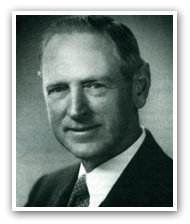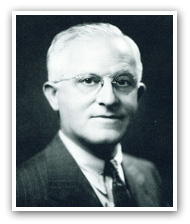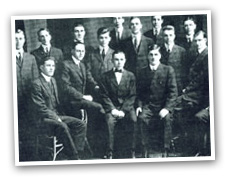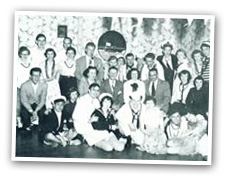History of the Delta Sigma Phi Fraternity
The Beginning

Charles A. Tonsor |

Meyer Boskey |
When the fall semester of 1899 began at the College of the City of, several students who had graduated together from the city high school system found themselves renewing their friendships as college freshmen. They gathered daily between classes in a building at CCNY. They wanted a means to continue their special ties of camaraderie during college and throughout life, and they soon settled on fraternity as the solution. They realized, however, that none of the several fraternities on campus would accept them as members because the group included both Jewish and Christian students during a time in which groups of mixed religions were not socially acceptable either to the all-Jewish or the all-Christian fraternities, or for that matter, to other segments of a stratified society. Yet these young men had already demonstrated to their complete satisfaction that there was no reason for religious prejudice or other discrimination among men of quality.
 |
|
Sigma Chapter, founded in 1915 |
To preserve their friendship and to establish that fundamental truth of life, these enlightened young men organized their own fraternity by December 10, 1899. Thus, a new fraternity named Delta Sigma Phi was founded in the new hope of the dawning of the twentieth century, based upon the highest ideals of mankind. The Fraternity has since grown in importance and reputation beyond even the most soaring imaginations of the founders. In 1901, a second chapter was established at Columbia University, only a short distance uptown. To distinguish between the two chapters and to proclaim the uniqueness of the organization, the Mother Chapter was called Insula, signifying its location on Manhattan Island. The second chapter was called Morningside for its location in Morningside Heights. Later these chapters were renamed as Alpha and Beta.
The Fraternity incorporated in New York State on December 15, 1902. At that time Delta Sigma Phi wrote into its laws the requirement of open membership to all college men of quality regardless of religion, race, or creed. The purpose of the Fraternity which was articulated in the 1902 Articles of Incorporation was ". . . to fulfill the desire of serious young college men for a fellowship and brotherhood, as near a practical working ideal as possible not fettered with too many traditional prejudices and artificial standards of membership, and accompanied by a clean, pure, and honorable chapter home life. "
A third chapter further uptown was organized at New York University in 1903. It was called University Chapter, and was later renamed Gamma. It is from these three founding chapters in New York City, working together, that Delta Sigma Phi has grown in size and strength to become one of the most important of collegiate fraternities.
 |
|
Early Sailor's Ball |
A constitutional convention was held in August of 1905 at Insula's apartment. Charles A. Tonsor, then a 19-year-old junior at NYU, was elected temporary president. Meyer Boskey, a founding father at the Insula Chapter and now a first year student at Brooklyn Law School, was elected temporary secretary. The Convention adopted a constitution, which created national offices and a council to govern between Conventions. New chapters, which had been organized at the Massachusetts Institute of Technology in 1904, called Technology (later Delta), and the Keystone Chapter (later Epsilon) at Pennsylvania State College, organized in 1905, were formally received into the Fraternity during the Convention.
The Development of a Fraternal Organization
In the fall of 1905, Tonsor and Boskey worked out the theme of the initiation ritual. They incorporated the sphinx as a major symbol of the Fraternity because it had been previously adopted as such by the members.
|
1949 Delta Sig Convention |
In April 1907, Boskey, having conceived the idea of a national magazine to bind the chapters together, published the first issue of the Carnation with his own funds. Thereafter, he produced the magazine at irregular intervals as a small pamphlet of only a few pages until the Convention of 1915 authorized its regular publication as the official magazine of the Fraternity. Upon the opening of his law firm in Manhattan in 1907, and until 1913, Boskey used his office, without compensation, as the communication center of the national organization, and he was annually re-elected secretary of the Fraternity.
Tonsor and Boskey, determined to keep the idealism of the Fraternity alive despite the desertion and defections, installed Iota at the University of Pennsylvania in 1908. At the 1908 convention, they and others sought to bridge the gap between the two disputing sides by a preamble to the constitution that expressed the philosophy of tolerance to opposing viewpoints. In 1909 Tonsor and Boskey attended the meeting of fraternities at the University Club in New York City at which the National Interfraternity Conference was formed. Delta Sigma Phi is a founding member of the NIC.
Milestone Years
|
Early Delta Sigs from UCLA |
At the 1923 Convention in Dallas, the adopted a ceremony for the dedication of new chapter houses and instituted the Pilgrim’s Degree, a special ritual for those making the pilgrimage to a National Convention. The convention also authorized the publication of The Sphinx, which has been issued since 1924 to convey confidential information to members.
In 1923, the first and only honorary member of the Fraternity was initiated. He was the Honorable. James J. Davis, Secretary of Labor in the Harding, Coolidge, and Hoover Cabinets. Initiated at the request of Omega Chapter, Brother Davis became an enthusiastic and loyal member.
In 1926, Alpha Chi Chapter originated the Sailors Ball, which has become traditional throughout the Fraternity. That year also saw the adoption of an official Fraternity flag by the Board of Governors.
The golden anniversary Convention was held in 1949. The goal of 50 chapters in 50 years had been more than fulfilled. There were 63, and all were represented at the Convention. The delegates took momentous action. They adopted a new constitution that provided for major changes in the national government of the Fraternity, expanding the Board of Governors to 18 members representing 18 regions, and leaving the interim affairs of the Fraternity in the hands of an executive committee.
The 1951 Convention voted to create the Delta Sigma Phi Foundation , a non-profit educational foundation. The final step in universal life membership was taken, with a resolution authorizing such membership of every initiate at the time of initiation, the practice followed today.
|
Delta Sigs in 1960 |
Under the direction of Executive Director E. Allen James, Rho, the Fraternity made rapid improvements. Over several years, the professional staff was increased in size to provide more services to chapters. The national headquarters was relocated from Denver to Indianapolis, Indiana in 1981. This move was accomplished in order to place the headquarters in a more central location for a majority of our chapters, and to take advantage of certain favorable tax laws. In 1984, the national offices were moved into the Taggart Mansion, which had been restored to its original grandeur to serve as the Fraternity's permanent seat of operations. It was formally dedicated at the 1985 convention that was held in Indianapolis.
In 1993, the fraternity established the college of Engineered Leadership, now called the Leadership Institute (LI), a corporate-style leadership experience for top undergrads, based on Hoge and Kinnison’s 1954 concept.
For more than a century, chapter quality and average size has increased dramatically as undergraduate members realized the potential of their own greatness. Many dormant chapters have been revived, and many new chapters have been added as Delta Sigma Phi has grown increasingly important in the fraternity movement.
